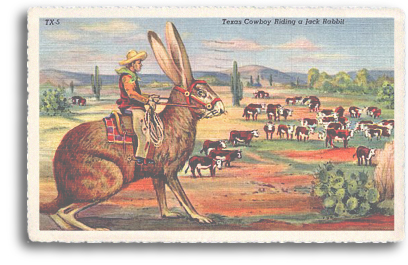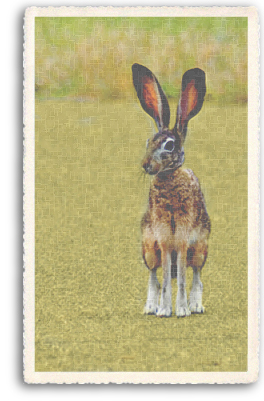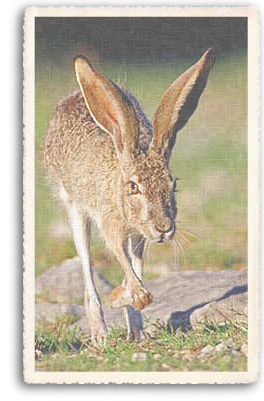 |
||
 Black-tailed Jack Rabbit Black-tailed Jack RabbitJack Rabbits are large, long-legged, long-eared hares that are found in western North America. Their classification is Genus Lepus, which includes many species of Jack Rabbits and other hares. Hares are similar to, but larger and leaner than rabbits, with coloration that is blackish to grayish. The Jack Rabbit’s length measures between 19 to 25 inches long, and its weight is around six to eight pounds. Its hind feet measure four to five inches in length. It has long, erect black tipped ears that resemble the ears of a donkey. Although the female and the male share physical characteristics, the female is larger. Jack Rabbits live in a variety of environments, including deserts, forests, grasslands, and prairies at elevations under 12,000 feet. The Black-tailed Jack Rabbit is a desert dweller and is found in all four Southwestern deserts: the Mojave, Sonoran, Chihuahuan, and Great Basin. It is the most abundant and widespread Jack Rabbit in the United States.  They adapt themselves readily to man’s use of the land and thrive even in highly developed areas. They adapt themselves readily to man’s use of the land and thrive even in highly developed areas.Jack Rabbits are true hares because, unlike the cottontailed rabbits, they do not build nests. The mother simply chooses a place to her liking and the young are born fully furred, with their eyes wide open. These hares grow rather rapidly and reach adult size in about seven or eight months. Sexual maturity is attained at about the same time, but young females do not breed until early in the year following their birth. Usually, the expectant mother provides no nest for her young. Jack Rabbits mate year round. They have one to six litters per year, with one to eight young per litter. The average litter is from two to four. The gestation period is 41 to 47 days. The newly-born Jack Rabbits are active after a short period of time. After only 30 days, they can fend for themselves. The life span of the Jack Rabbit is five to six years, but hares in the wild die sooner due to problems of over population, disease and predation. Hares are active primarily at night. During the day they lie crouched in a “form” which they have made by using the same spot in a clump of grass or weeds. With their long ears flattened against their back, they are difficult to see. Frequently on hot summer days, they can be seen resting in the shade of a small bush or even a fence post. When frightened they run with such speed that few dogs can catch them. At the start of the chase their speed is broken by high long leaps. The Black-tailed Jack Rabbit is essentially a solitary animal which most frequently is seen feeding conspicuously in open fields during late afternoon, evenings and early mornings, or resting in the shade of a fence post or shrub in the middle of the day. When disturbed, it escapes with abrupt, rapid acceleration, as it leaps across the open  fields. If attacked, these hares defend themselves by forcefully kicking with their hind feet, biting, and emitting a shrieking call. They maintain trails between feeding and resting areas. fields. If attacked, these hares defend themselves by forcefully kicking with their hind feet, biting, and emitting a shrieking call. They maintain trails between feeding and resting areas.In the summer, the Black-tailed Jack Rabbit spends the hottest part of the day dozing in a bed scratched out at the base of some shrub or in a clump of tall grass where the shade will protect it from the heat. In the winter such beds are located among plants that will shield the rabbit from the cold wind. The hare’s long ears also help to shield it from the heat and the cold. The Jack Rabbit is more active at night, and its eyes focus well in the dark. They are always aware of their surroundings and potential danger and rely on their speed to escape from predators such as coyotes, bobcats, foxes, horned owls, hawks and snakes. While escaping, they will flash the white underside of their tail to alert other rabbits in the area. Thumping the ground with their big hind feet is a signal of nearby danger. They can jump 20 feet in a bounce and reach a top speed of 30 to 35 mph over a zig-zag course. The Jack Rabbit’s diet consists of grasses, herbage, and any available green vegetation. In the summer, they eat grasses and leafy plants. In winter, more dry vegetation is consumed, including cacti, shrubs, and the bark of trees. Most of their water is obtained from the plants they eat. The Jack Rabbit eats constantly and consumes large quantities relative to its size: 15 Jack Rabbits eat as much as one large grazing cow in one day. Jackalope Desert Cottontail Rabbit Back to Plants & Wildlife |
||
Home | Food | Lodging | Merchants | Services | Real Estate | Art & Galleries | Entertainment | Recreation Ski Areas | Mind-Body-Spirit | Taos Information | Local Color | Taos Pueblo | High Road to Taos | Taos Plaza | Ranchos de Taos Scenic Beauty | Day Trips | Chili | Special Events | Taos History | Multicultures | Museums | The Enchanted Circle The Wild West | Taos Art Colony | Plants & Wildlife | Counterculture | Turquoise | Architecture | Features | About Us | Get Listed! Taos Unlimited Trading Post | Photo of the Week | Link of the Month | Taos Webcams | Taos Weather | Testimonials | Guestbook Taos A to Z | Movie Locations | Sitemap | Taos Unlimited Blog | Aimee & Jean's Story Blog | Contact Us | Santa Fe Unlimited |
||